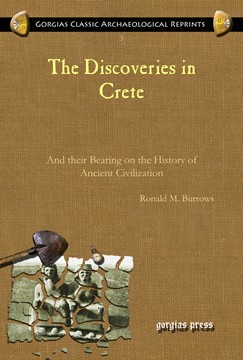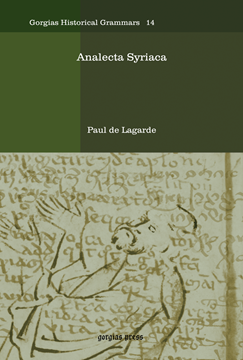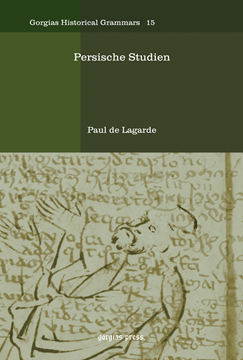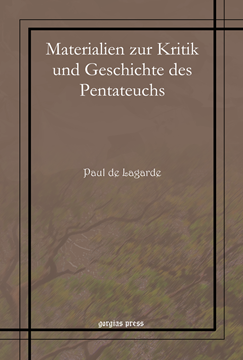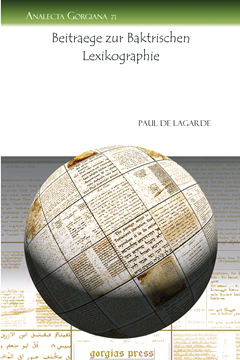An Estimate
ISBN: 978-1-59333-954-8
Concerned with the continuing, and growing, anti-Semitism of his day, Jacobs laid out a statement of the Jewish contribution to civilization. Beginning with the convention of Jewish self-recognition as the people of the book, he sketches the relationship between the church and the Jews. He notes that Jews in the Middle Ages were intellectual intermediaries and their works had a profound impact on Medieval thought. Their roles in commerce and capitalism are explored. Noting the contribution throughout history of Jews to the cause of liberality, Jacob makes a profound case for seeing the deep impact Judaism has made on the modern world.
$166.00 (USD) $99.60 (USD)
The Discoveries in Crete
And their Bearing on the History of Ancient Civilization
Series: Kiraz Classic Archaeological Reprints 3
ISBN: 978-1-59333-955-5
Indeed a classic of accessible archaeological writing, Burrows’ study of ancient Crete was one of the main contributors to the commencement of modern understanding of the Minoans. The earliest traces of the Minoan civilization are sketched out before he turns to the historical periods when Minos flourished. The sack of Knossos and the end of the Bronze Age are narrated against the archaeological background. Aware of the cultural continuity of classical stories from the island, he introduces the topic of the minotaur and the famed labyrinth of Knossos. For anyone interested in the roots of western civilization, or of the founding of classical civilizations, this book remains an essential reading.
$149.00 (USD) $89.40 (USD)
Analecta Syriaca
Series: Kiraz Historical Grammars Archive 14
ISBN: 978-1-59333-959-3
A rare edition of Lagarde’s Syriac ephemera, this volume is a linguist’s delight. Introduced in Latin and Arabic, the descriptions and annotations to Syriac manuscripts that constitute this book will seldom be found elsewhere. The various Syriac codices included in the collection are presented in Syriac without translation. For the student of Syriac who is seeking the authentic experience of reading Syriac materials, this study will be a treasury of material. Over the decades, Legarde’s works have become increasingly difficult to locate, and Gorgias Press is pleased to be able to offer this collectable again.
$148.00 (USD) $88.80 (USD)
Persische Studien
Series: Kiraz Historical Grammars Archive 15
ISBN: 978-1-59333-960-9
The astute observations of linguist Paul de Lagarde on Persian manuscript in Europe predating 1700 make an essential catalogue for anyone interested in the state of the field in the late 19th century. Citing each manuscript, Lagarde provides an annotated catalogue of 61 pieces that include descriptions from the initial publication of each text as well as his own observations. His study gives a sense of importance of each piece considered, demonstrating their relationships with other known documents. Also included in this unique study are the Judeo-Persian versions of the prophets Isaiah, Jeremiah, and Ezekiel (the latter only through chapter 9).
$136.00 (USD) $81.60 (USD)
Materialien zur Kritik und Geschichte des Pentateuchs
ISBN: 978-1-59333-962-3
Originally published in two volumes, this edition of the Arabic translation of the Pentateuch stands as one of Lagarde’s lasting contributions to biblical scholarship. Critical editions make frequent reference to this work. Included are two translations of Genesis into Arabic, along with a single version of the remaining pentateuchal books, also in Arabic. The first translation of Genesis represents the tradition of the Paris Polyglot, translated directly from the Hebrew, while the second is a cantena text from the Syriac tradition, representing two-thirds of Genesis. Lagarde’s study provides a valuable text-critical tool and easy access to the Arabic versions of the material.
$189.00 (USD) $113.40 (USD)
Beitraege zur Baktrischen Lexikographie
Series: Analecta Gorgiana 71
ISBN: 978-1-59333-963-0
One of the few scholars of biblical languages to reach so far into the cultural world of antiquity, de Lagarde here offers a brief contribution to the study of Bactrian lexicography. This brief study grew out of the author’s long-standing appreciation for the related Persian languages and literature. While not a full-fledged dictionary, de Lagarde here provides discussions of over one hundred words, some of them offered in considerable detail. For the linguist interested in the history of the study of this particular language, this handbook will prove an invaluable tool.
$48.00 (USD) $28.80 (USD)

